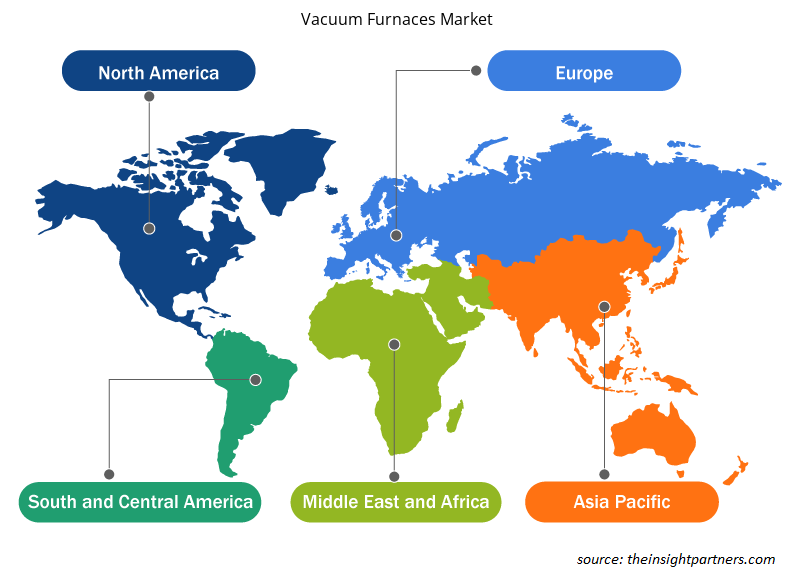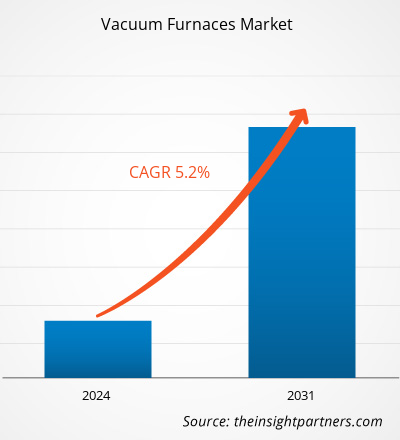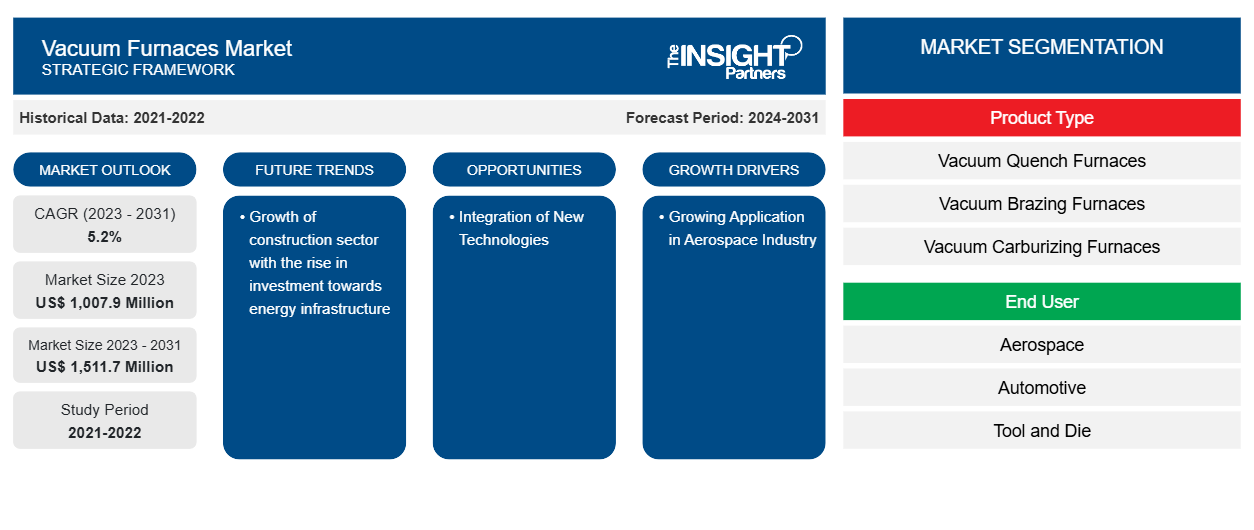Se proyecta que el tamaño del mercado de hornos de vacío alcance los 1.511,7 millones de dólares estadounidenses en 2031, frente a los 1.007,9 millones de dólares estadounidenses en 2023. Se espera que el mercado registre una CAGR del 5,2 % durante el período 2023-2031. Es probable que el crecimiento del sector de la construcción, junto con el aumento de la inversión en infraestructura energética, siga siendo una tendencia clave en el mercado.
Análisis del mercado de hornos de vacío
Se prevé que el aumento de la demanda de hornos de vacío para aplicaciones industriales impulse el crecimiento del mercado en los próximos años. Además, se espera que el uso creciente de hornos de vacío en la industria aeroespacial y de defensa impulse el crecimiento del mercado en los próximos años. Además, se prevé que el crecimiento del sector de la construcción en las regiones en desarrollo y desarrolladas de todo el mundo y un aumento de la inversión en infraestructura energética para satisfacer la demanda de electricidad creen oportunidades para los principales fabricantes de hornos de vacío entre 2023 y 2031.
Descripción general del mercado de hornos de vacío
El ecosistema de hornos de vacío consta de tres partes interesadas principales, como proveedores de materias primas, fabricantes de hornos de vacío y usuarios finales. Los proveedores de los proveedores de materias primas incluyen las empresas que proporcionan diversas materias primas para ensamblar y diseñar hornos para la aplicación deseada. Por ejemplo, algunos de los principales tipos de productos son metales, actuadores, motores y accionamientos, entre otros tipos de productos. Los fabricantes de hornos de vacío recopilan materias primas para construir una variedad de hornos de vacío para diversas aplicaciones para diferentes verticales de la industria. Las empresas del sector del usuario final utilizan estos hornos de vacío para una variedad de productos. La creciente tendencia de la estructuración de premoldeo, la Industria 4.0, la implementación de tecnologías como IoT y la computación en la nube , junto con la creciente demanda de sistemas de automatización eficientes en todas las industrias son algunos de los factores clave que están impulsando la demanda de hornos de vacío.
Personalice este informe según sus necesidades
Obtendrá personalización en cualquier informe, sin cargo, incluidas partes de este informe o análisis a nivel de país, paquete de datos de Excel, así como también grandes ofertas y descuentos para empresas emergentes y universidades.
-
Obtenga las principales tendencias clave del mercado de este informe.Esta muestra GRATUITA incluirá análisis de datos, desde tendencias del mercado hasta estimaciones y pronósticos.
Impulsores y oportunidades del mercado de hornos de vacío
Aplicación creciente en la industria aeroespacial para favorecer el mercado
La industria aeroespacial es uno de los principales usuarios finales de hornos de vacío. Como el tratamiento térmico se utiliza en la industria aeroespacial para mejorar la resistencia de varios componentes al desgaste y la corrosión, los métodos principales implican el tratamiento térmico de piezas de motores sometidas a tensiones y esfuerzos mecánicos. Como ofrece alta confiabilidad, un espacio de instalación más pequeño y facilidad de mantenimiento, el tratamiento térmico en horno de vacío vertical se utiliza para calentar piezas con una sección transversal cilíndrica o piezas que se pueden apilar verticalmente, lo que se procesa comúnmente en la industria aeroespacial. Los hornos de vacío se utilizan para soldadura fuerte, recocido, tratamiento en solución, envejecimiento, endurecimiento, alivio de tensiones y otros tratamientos térmicos. Como resultado, el mercado de hornos de vacío está creciendo debido a la amplia gama de aplicaciones en la industria aeroespacial.
Además, la industria aeroespacial y de defensa (A&D) está involucrada en el desarrollo de nuevas tecnologías y soluciones, ampliando las perspectivas de desarrollo y estableciendo nuevos mercados. Las nuevas tecnologías y procesos que evolucionan rápidamente y se comercializan pueden mejorar la eficiencia y reducir los costos de producción. Las tendencias en el aumento de los viajes aéreos comerciales y la actividad de pedidos de los clientes son sustancialmente mejores que en la era anterior al COVID-19, un presagio alcista para el negocio. La distribución mundial de la vacuna COVID-19 ayuda a la normalización de los viajes aéreos. Por lo tanto, la reactivación de la industria aeroespacial impulsa el mercado de los hornos de vacío.
Integración de Nuevas Tecnologías
El futuro de la tecnología de procesamiento térmico metalúrgico está cambiando continuamente. La tecnología de hornos de vacío es bien conocida y utilizada por los industriales de ingeniería con la visión de establecer esta tecnología de proceso como un vehículo capaz de permitir muchas de las nuevas transformaciones termometalúrgicas de los productos de ingeniería y manufacturados actuales. De acuerdo con las tendencias internacionales existentes y esperadas, la tecnología de hornos de vacío actualmente tiene un potencial significativo para continuar desarrollándose en el futuro. Es una tecnología que permitirá a la ciencia de los materiales y a sus socios industriales ingresar fácilmente al tercer milenio. Por lo tanto, la tecnología de procesamiento térmico al vacío juega un papel esencial en la soldadura fuerte de aleaciones de aluminio no ferrosas geométricas complejas.
Análisis de segmentación del informe de mercado de hornos de vacío
Los segmentos clave que contribuyeron a la derivación del análisis del mercado de hornos de vacío son el tipo de producto y el usuario final.
- Según el tipo de producto, el mercado de hornos de vacío se divide en hornos de temple al vacío, hornos de soldadura fuerte al vacío, hornos de carburación al vacío y otros. El segmento de hornos de temple al vacío tuvo la mayor participación de mercado en 2023.carburizing furnaces, and others. The vacuum quench furnaces segment held the largest market share in 2023.
- Por usuario final, el mercado se clasifica en aeroespacial, automotriz, herramientas y matrices, generación de energía y otros. El segmento aeroespacial tuvo la mayor participación de mercado en 2023.
Análisis de la cuota de mercado de hornos de vacío por geografía
El alcance geográfico del informe de mercado de hornos de vacío se divide principalmente en cinco regiones: América del Norte, Asia Pacífico, Europa, Medio Oriente y África, y América del Sur.
El alcance del informe de mercado de hornos de vacío abarca América del Norte (EE. UU., Canadá y México), Europa (Alemania, Francia, Italia, España, Reino Unido y resto de Europa), Asia Pacífico (China, India, Australia, Japón, Corea del Sur y el resto de Asia Pacífico), Oriente Medio y África (Sudáfrica, Arabia Saudita, Emiratos Árabes Unidos y el resto de Oriente Medio y África) y América del Sur (Brasil, Argentina y el resto de América del Sur). En términos de ingresos, Asia Pacífico dominó la participación de mercado de hornos de vacío en 2023. Europa fue el segundo mayor contribuyente de ingresos al mercado mundial de hornos de vacío, seguida de América del Norte.UAE, and Rest of Middle East & Africa), and South America (Brazil, Argentina, and the Rest of South America). In terms of revenue, Asia Pacific dominated the vacuum furnaces market share in 2023. Europe was the second-largest revenue contributor to the global vacuum furnaces market, followed by North America.
Perspectivas regionales del mercado de hornos de vacío
Los analistas de Insight Partners explicaron en detalle las tendencias y los factores regionales que influyen en el mercado de hornos de vacío durante el período de pronóstico. Esta sección también analiza los segmentos y la geografía del mercado de hornos de vacío en América del Norte, Europa, Asia Pacífico, Oriente Medio y África, y América del Sur y Central.

- Obtenga datos regionales específicos para el mercado de hornos de vacío
Alcance del informe de mercado de hornos de vacío
| Atributo del informe | Detalles |
|---|---|
| Tamaño del mercado en 2023 | US$ 1.007,9 millones |
| Tamaño del mercado en 2031 | US$ 1.511,7 millones |
| CAGR global (2023 - 2031) | 5,2% |
| Datos históricos | 2021-2022 |
| Período de pronóstico | 2024-2031 |
| Segmentos cubiertos |
Por tipo de producto
|
| Regiones y países cubiertos |
América del norte
|
| Líderes del mercado y perfiles de empresas clave |
|
Densidad de actores del mercado de hornos de vacío: comprensión de su impacto en la dinámica empresarial
El mercado de hornos de vacío está creciendo rápidamente, impulsado por la creciente demanda de los usuarios finales debido a factores como la evolución de las preferencias de los consumidores, los avances tecnológicos y una mayor conciencia de los beneficios del producto. A medida que aumenta la demanda, las empresas amplían sus ofertas, innovan para satisfacer las necesidades de los consumidores y aprovechan las tendencias emergentes, lo que impulsa aún más el crecimiento del mercado.
La densidad de actores del mercado se refiere a la distribución de las empresas o firmas que operan dentro de un mercado o industria en particular. Indica cuántos competidores (actores del mercado) están presentes en un espacio de mercado determinado en relación con su tamaño o valor total de mercado.
Las principales empresas que operan en el mercado de hornos de vacío son:
- AMG Metalúrgica Avanzada
- Tecnologías de vacío ALD
- Industrias de vacío Centorr
- Compañía Chugai RO Co., Ltd.
- Tecnologías ECM
- HHV Ltd
Descargo de responsabilidad : Las empresas enumeradas anteriormente no están clasificadas en ningún orden particular.

- Obtenga una descripción general de los principales actores clave del mercado de hornos de vacío
Noticias y desarrollos recientes del mercado de hornos de vacío
El mercado de hornos de vacío se evalúa mediante la recopilación de datos cualitativos y cuantitativos a partir de una investigación primaria y secundaria, que incluye publicaciones corporativas importantes, datos de asociaciones y bases de datos. A continuación, se enumeran algunos de los avances en el mercado de hornos de vacío:
- HHV y ASM Technologies han formado una empresa conjunta para la fabricación de equipos de semiconductores. Ambas empresas han formado una empresa conjunta al 50 %. La nueva entidad así formada fabricará herramientas, componentes de subsistemas y componentes para las industrias de semiconductores y solar. (Fuente: HHV Ltd, comunicado de prensa, febrero de 2022)
- Ipsen está ampliando sus capacidades de servicio al incorporar pruebas de espesor de pared por ultrasonidos para hornos de vacío. Esta prueba ayudaría a identificar la integridad de sus cámaras y estimar su vida útil en consecuencia. (Fuente: Ipsen, comunicado de prensa, febrero de 2022)
Informe de mercado sobre hornos de vacío: cobertura y resultados
El informe “Tamaño y pronóstico del mercado de hornos de vacío (2021-2031)” proporciona un análisis detallado del mercado de hornos de vacío que cubre las siguientes áreas:
- Tamaño del mercado de hornos de vacío y pronóstico a nivel mundial, regional y nacional para todos los segmentos clave del mercado cubiertos bajo el alcance
- Tendencias del mercado de hornos de vacío, así como dinámica del mercado, como impulsores, restricciones y oportunidades clave
- Análisis PEST y FODA detallados
- Análisis del mercado de hornos de vacío que cubre las tendencias clave del mercado, el marco global y regional, los principales actores, las regulaciones y los desarrollos recientes del mercado.
- Análisis del panorama de la industria y de la competencia que abarca la concentración del mercado, el análisis de mapas de calor, los actores destacados y los desarrollos recientes del mercado de hornos de vacío
- Perfiles detallados de empresas
- Análisis histórico (2 años), año base, pronóstico (7 años) con CAGR
- Análisis PEST y FODA
- Tamaño del mercado, valor/volumen: global, regional y nacional
- Industria y panorama competitivo
- Conjunto de datos de Excel
Informes recientes
Testimonios
Razón para comprar
- Toma de decisiones informada
- Comprensión de la dinámica del mercado
- Análisis competitivo
- Información sobre clientes
- Pronósticos del mercado
- Mitigación de riesgos
- Planificación estratégica
- Justificación de la inversión
- Identificación de mercados emergentes
- Mejora de las estrategias de marketing
- Impulso de la eficiencia operativa
- Alineación con las tendencias regulatorias























 Obtenga una muestra gratuita para - Mercado de hornos de vacío
Obtenga una muestra gratuita para - Mercado de hornos de vacío